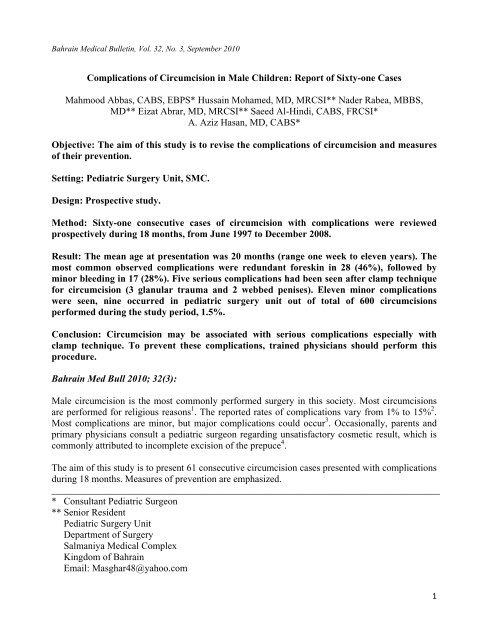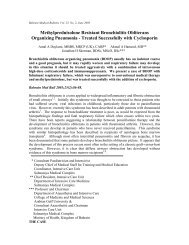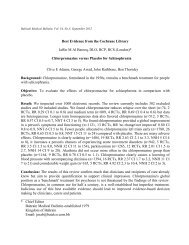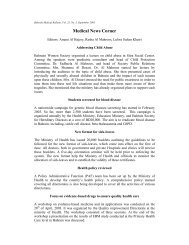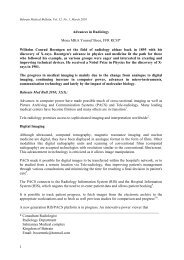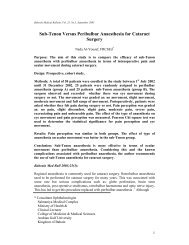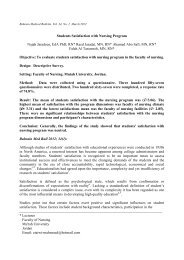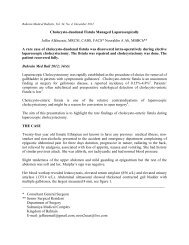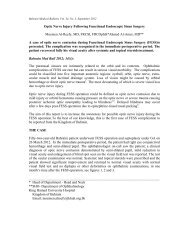Complications of Circumcision in Male Children: Report of Sixty-one ...
Complications of Circumcision in Male Children: Report of Sixty-one ...
Complications of Circumcision in Male Children: Report of Sixty-one ...
Create successful ePaper yourself
Turn your PDF publications into a flip-book with our unique Google optimized e-Paper software.
Bahra<strong>in</strong> Medical Bullet<strong>in</strong>, Vol. 32, No. 3, September 2010<br />
<strong>Complications</strong> <strong>of</strong> <strong>Circumcision</strong> <strong>in</strong> <strong>Male</strong> <strong>Children</strong>: <strong>Report</strong> <strong>of</strong> <strong>Sixty</strong>-<strong>one</strong> Cases<br />
Mahmood Abbas, CABS, EBPS* Hussa<strong>in</strong> Mohamed, MD, MRCSI** Nader Rabea, MBBS,<br />
MD** Eizat Abrar, MD, MRCSI** Saeed Al-H<strong>in</strong>di, CABS, FRCSI*<br />
A. Aziz Hasan, MD, CABS*<br />
Objective: The aim <strong>of</strong> this study is to revise the complications <strong>of</strong> circumcision and measures<br />
<strong>of</strong> their prevention.<br />
Sett<strong>in</strong>g: Pediatric Surgery Unit, SMC.<br />
Design: Prospective study.<br />
Method: <strong>Sixty</strong>-<strong>one</strong> consecutive cases <strong>of</strong> circumcision with complications were reviewed<br />
prospectively dur<strong>in</strong>g 18 months, from June 1997 to December 2008.<br />
Result: The mean age at presentation was 20 months (range <strong>one</strong> week to eleven years). The<br />
most common observed complications were redundant foresk<strong>in</strong> <strong>in</strong> 28 (46%), followed by<br />
m<strong>in</strong>or bleed<strong>in</strong>g <strong>in</strong> 17 (28%). Five serious complications had been seen after clamp technique<br />
for circumcision (3 glanular trauma and 2 webbed penises). Eleven m<strong>in</strong>or complications<br />
were seen, n<strong>in</strong>e occurred <strong>in</strong> pediatric surgery unit out <strong>of</strong> total <strong>of</strong> 600 circumcisions<br />
performed dur<strong>in</strong>g the study period, 1.5%.<br />
Conclusion: <strong>Circumcision</strong> may be associated with serious complications especially with<br />
clamp technique. To prevent these complications, tra<strong>in</strong>ed physicians should perform this<br />
procedure.<br />
Bahra<strong>in</strong> Med Bull 2010; 32(3):<br />
<strong>Male</strong> circumcision is the most commonly performed surgery <strong>in</strong> this society. Most circumcisions<br />
are performed for religious reasons 1 . The reported rates <strong>of</strong> complications vary from 1% to 15% 2 .<br />
Most complications are m<strong>in</strong>or, but major complications could occur 3 . Occasionally, parents and<br />
primary physicians consult a pediatric surgeon regard<strong>in</strong>g unsatisfactory cosmetic result, which is<br />
commonly attributed to <strong>in</strong>complete excision <strong>of</strong> the prepuce 4 .<br />
The aim <strong>of</strong> this study is to present 61 consecutive circumcision cases presented with complications<br />
dur<strong>in</strong>g 18 months. Measures <strong>of</strong> prevention are emphasized.<br />
________________________________________________________________________________<br />
* Consultant Pediatric Surgeon<br />
** Senior Resident<br />
Pediatric Surgery Unit<br />
Department <strong>of</strong> Surgery<br />
Salmaniya Medical Complex<br />
K<strong>in</strong>gdom <strong>of</strong> Bahra<strong>in</strong><br />
Email: Masghar48@yahoo.com<br />
1
METHOD<br />
Prospective study <strong>of</strong> sixty-<strong>one</strong> consecutive circumcision patients with complications presented to<br />
pediatric surgery unit dur<strong>in</strong>g 18 months (June 2007 to December 2008) were evaluated. Data<br />
<strong>in</strong>cluded age, technique <strong>of</strong> circumcision, age <strong>of</strong> referral to our unit, ma<strong>in</strong> compla<strong>in</strong>ts <strong>of</strong> the parents,<br />
type <strong>of</strong> the complication and the treatment. The specialty <strong>of</strong> the physician who performed the<br />
<strong>in</strong>itial procedure was identified. No cases with complications <strong>of</strong> circumcision were excluded<br />
dur<strong>in</strong>g that period.<br />
RESULT<br />
An average <strong>of</strong> four hundred thirty-two circumcisions is performed yearly <strong>in</strong> pediatric surgery unit,<br />
SMC. N<strong>in</strong>e complications occurred <strong>in</strong> pediatric surgery unit out <strong>of</strong> total <strong>of</strong> 600 circumcisions<br />
performed dur<strong>in</strong>g the study period, 1.5%.<br />
<strong>Sixty</strong>-<strong>one</strong> consecutive circumcision cases with complications were seen <strong>in</strong> the pediatric surgery<br />
unit, SMC. The mean age at presentation was 20 months (range <strong>one</strong> week to eleven years).<br />
The most common observed complications were redundant foresk<strong>in</strong> <strong>in</strong> 28 (46%), followed by<br />
m<strong>in</strong>or bleed<strong>in</strong>g <strong>in</strong> 17 (28%). Five serious complications had been seen after clamp technique for<br />
circumcision (3 glanular trauma and 2 webbed penises).<br />
Only 10 cases (16.4%) had the primary procedure <strong>in</strong> Salmaniya Medical Complex. The majority,<br />
51 cases (83.6%), were circumcised <strong>in</strong> other hospitals and cl<strong>in</strong>ics by general physicians, family<br />
physicians and pediatricians. The patients’ ages at circumcision were between <strong>one</strong> week and 3.2<br />
years (mean <strong>of</strong> 3.6 months); nearly half <strong>of</strong> them (35 cases) were operated at or below 1 month <strong>of</strong><br />
age. The age <strong>of</strong> referral to our unit after circumcision ranges from <strong>one</strong> week to 11 years (mean 20<br />
months). The method <strong>of</strong> circumcision was Plastibell technique <strong>in</strong> 32 cases (52.5%), cutt<strong>in</strong>g or<br />
clamps <strong>in</strong> 29 cases (47.5%). Eleven m<strong>in</strong>or complications were seen, n<strong>in</strong>e m<strong>in</strong>or complications<br />
(14.8%) occurred <strong>in</strong> pediatric surgery unit, SMC: bleed<strong>in</strong>g (five cases), adhesions (three cases),<br />
urethral stenosis (<strong>one</strong> case) and reta<strong>in</strong>ed Plastibell (<strong>one</strong> case). Table 1 summarizes the types <strong>of</strong><br />
complications.<br />
All complications required a second procedure, either under local or general anesthesia, to treat the<br />
complication. After follow up <strong>of</strong> 12 months, all patients <strong>in</strong> this study had satisfactory cosmetic<br />
outcome and n<strong>one</strong> <strong>of</strong> them developed complications or required a second revision.<br />
2
Table 1: Types <strong>of</strong> <strong>Complications</strong><br />
Type <strong>of</strong> Complication Number <strong>of</strong> patients (%)<br />
Redundant foresk<strong>in</strong>* 28 (46%)<br />
Bleed<strong>in</strong>g 17 (28%)<br />
Glanular <strong>in</strong>jury 3 (5%)<br />
Phimosis 3 (5%)<br />
Meatal stenosis 3 (5%)<br />
Webbed penis 2 (3%)<br />
Inclusion cyst 2 (3%)<br />
Reta<strong>in</strong>ed Plastibell 2 (3%)<br />
Wound separation 1 (2%)<br />
Total<br />
* With and without adhesions<br />
61<br />
The most common complication <strong>in</strong> this study was redundant foresk<strong>in</strong> (46%), which caused<br />
hygiene problem and required excision <strong>of</strong> the excess foresk<strong>in</strong>. N<strong>one</strong> bleed<strong>in</strong>g cases required blood<br />
transfusion or prolonged admission. Five <strong>of</strong> the patients who were circumcised by clamp technique<br />
developed serious complications. Two cases presented with bleed<strong>in</strong>g and amputation <strong>of</strong> the<br />
perimeatal glanular tissue and required urethral catheterization for few days. One case presented<br />
with partial amputation <strong>of</strong> the left glanular w<strong>in</strong>g result<strong>in</strong>g <strong>in</strong> hypospadic meatus that required<br />
surgical repair (Figure 1). Excessive removal <strong>of</strong> ventral sk<strong>in</strong> <strong>of</strong> the shaft resulted <strong>in</strong> webbed penis<br />
<strong>in</strong> two cases and required surgical correction.<br />
(a) Glanular Trauma (b) Phimosis (c) Excess Foresk<strong>in</strong> (d) Webbed Penis<br />
Figure 1 (a, b, c, d): Shows Some <strong>Complications</strong> <strong>of</strong> <strong>Circumcision</strong><br />
DISCUSSION<br />
<strong>Male</strong> circumcision is <strong>one</strong> <strong>of</strong> the most common surgical procedures performed around the world. It<br />
is usually performed for religious reasons and less commonly <strong>in</strong>dicated for medical reasons 5 .<br />
Complication rates vary from 1% to 15% 2 . Most <strong>of</strong> the complications are m<strong>in</strong>or, such as bleed<strong>in</strong>g,<br />
preputial adhesions and penile cysts. Major complications such as glanular or penile amputations,<br />
urethrocutaneous fistula and iatrogenic hypospadias could occur 3 .<br />
3
Surgical and medical doctors perform many circumcisions <strong>in</strong> health centers, private cl<strong>in</strong>ics and<br />
private hospitals. Consequently, these children are rendered at risk for various complications<br />
especially if <strong>in</strong>experienced physicians perform the procedure.<br />
Despite the procedure is be<strong>in</strong>g performed by different specialists, the majority <strong>of</strong> children obta<strong>in</strong><br />
good to excellent results 4 . On occasion, the results are unsatisfactory to the parents or primary care<br />
physician because <strong>of</strong> excess redundant foresk<strong>in</strong> and many <strong>of</strong> these children are referred to a<br />
pediatric surgeon. A study <strong>of</strong> circumcision has suggested that there is no improvement <strong>in</strong> the<br />
appearance <strong>of</strong> the redundant foresk<strong>in</strong> with age and another study found that redundant foresk<strong>in</strong><br />
caus<strong>in</strong>g recurrent posthitis was an <strong>in</strong>dication for surgery <strong>in</strong> 15% <strong>of</strong> cases referred for circumcision<br />
revision 6,7 . In general, excess foresk<strong>in</strong> causes mild adhesions, which could be released easily <strong>in</strong> the<br />
cl<strong>in</strong>ic. Revision <strong>of</strong> circumcision is reserved for those cases with dense glanular adhesions,<br />
recurrent <strong>in</strong>fections, difficulty <strong>in</strong> hygiene and cases with uncircumcised appearance <strong>of</strong> the penis.<br />
Revision is usually performed by sleeve technique. This easy technique allows accurate removal <strong>of</strong><br />
excess mucosa without excis<strong>in</strong>g the sk<strong>in</strong> and produces excellent cosmetic result. Revision <strong>of</strong><br />
circumcision by clamp technique is difficult and risky especially <strong>in</strong> <strong>in</strong>experienced hands 4 . In<br />
general, the complication rate <strong>of</strong> circumcision revision is very low 4 .<br />
The ideal age for circumcision is controversial. The current recommendations are without<br />
satisfactory pro<strong>of</strong>, suggest<strong>in</strong>g that circumcision <strong>in</strong> neonates carries higher complication rate and<br />
should be delayed for 6 months after birth 8,9 . On the other hand, it is a commonly held religious<br />
belief by many parents that circumcision should be performed at age <strong>of</strong> 7 days. A recent study<br />
supported the later op<strong>in</strong>ion showed that neonatal circumcision is pa<strong>in</strong> free and carries m<strong>in</strong>or<br />
complication rate 10 . We believe that neonatal circumcision is a safe procedure <strong>in</strong> the hands <strong>of</strong> an<br />
experienced physician.<br />
Serious complications can be prevented by mark<strong>in</strong>g the l<strong>in</strong>e <strong>of</strong> excision and avoid<strong>in</strong>g excessive<br />
traction on the foresk<strong>in</strong> dur<strong>in</strong>g clamp application. Those who are not familiar with clamp<br />
technique better do the procedure us<strong>in</strong>g the plastibell which is a safe device and does not cause<br />
major complications.<br />
S<strong>in</strong>ce circumcision is a common procedure and practiced by many medical specialists,<br />
complications are expected to cont<strong>in</strong>ue. In order to prevent major complications, standard rules<br />
and regulations should be developed and qualified physicians should perform the procedure. This<br />
should <strong>in</strong>clude a didactic tra<strong>in</strong><strong>in</strong>g course and a period <strong>of</strong> direct supervision before perform<strong>in</strong>g this<br />
procedure <strong>in</strong>dependently.<br />
CONCLUSION<br />
<strong>Circumcision</strong> is a common procedure and carries small but serious risks and complications<br />
especially when us<strong>in</strong>g clamps. These complications can be avoided if the procedure is<br />
licensed to those who had adequate tra<strong>in</strong><strong>in</strong>g.<br />
REFERENCES<br />
1. Moses S, Bailey RC, Ronald AR. <strong>Male</strong> <strong>Circumcision</strong>: Assessment <strong>of</strong> Health Benefits and<br />
Risks. Sex Transm Infect 1998; 74(5): 368-73.<br />
4
2. Harrison NW, Eshelman JL, Ngugi PM. Ethical Issues <strong>in</strong> the Develop<strong>in</strong>g World. Br J Urol<br />
1995; 76 (Suppl 2): 93-6.<br />
3. Ceylan K, Burhan K, Yilmaz Y, et al. Severe <strong>Complications</strong> <strong>of</strong> <strong>Circumcision</strong>: An Analysis<br />
<strong>of</strong> 48 Cases. J Pediatr Urol 2007; 3(1): 32-5.<br />
4. Brisson PA, Patel HI, Fe<strong>in</strong>s NR. Revision <strong>of</strong> <strong>Circumcision</strong> <strong>in</strong> <strong>Children</strong>: <strong>Report</strong> <strong>of</strong> 56 Cases.<br />
J Pediatr Surg 2002; 37(9): 1343-6.<br />
5. Hirji H, Charlton R, Sarmah S. <strong>Male</strong> <strong>Circumcision</strong>: A Review <strong>of</strong> the Evidence. JMHG<br />
2005; 2(1): 21-30.<br />
6. Breuer GS, Walfisch S: <strong>Circumcision</strong> <strong>Complications</strong> and Indications for Ritual<br />
<strong>Circumcision</strong>s: Cl<strong>in</strong>ical Experience and Review <strong>of</strong> the Literature. Isr J Med Sci 1987;<br />
23(4): 252-6.<br />
7. Redman JF. <strong>Circumcision</strong> Revision <strong>in</strong> Prepubertal Boys: Analysis <strong>of</strong> a 2 Year Experience<br />
and Description <strong>of</strong> a Technique. J Urol 1995; 153(1): 180-2.<br />
8. Spilsbury K, Semmens Jb, Wisniewsk Zs, et al. Rout<strong>in</strong>e <strong>Circumcision</strong> Practice <strong>in</strong> Western<br />
Australia 1981-1999. Anz Journal <strong>of</strong> Surgery 2003; 73(8): 610-4.<br />
9. Machmouchi M, Alkhotani A. Is Neonatal <strong>Circumcision</strong> Judicious? Eur J Pediatr Surg<br />
2007; 17(4): 2661-9.<br />
10. Banieghbal B. Optimal Time for Neonatal <strong>Circumcision</strong>: An Observation-Based Study. J<br />
Pediatr Urol 2009; 5(5): 359-62.<br />
5


